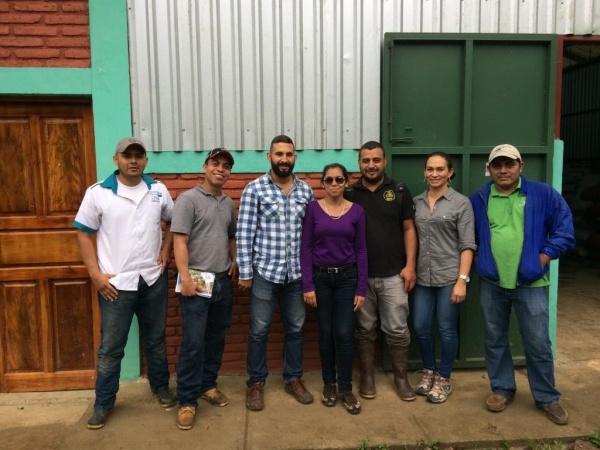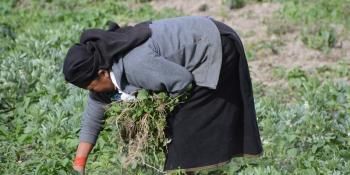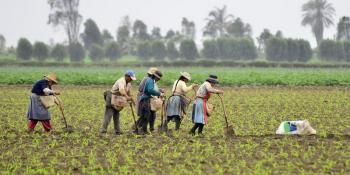Sustainable processes in the hands of local actors

Strengthening the capacities of local actors in the Climate-Smart Village of El Tuma-La Dalia.
Also available in Spanish
One of the most important mandates for the CGIAR Research Centers is the creation and strengthening of local capacities as a pillar of sustainable processes. Therefore, the week of October 16 to 20 in 2017, a team from the CGIAR Research Program on Climate Change, Agriculture and Food Security (CCAFS) and The Tropical Agricultural Research and Higher Education Center (CATIE) developed the first capacity-building workshop. This targeted technical personnel and facilitators of the Participatory Integrated Climate Services for Agriculture (PICSA) approach, and families participating in the Farmer Field School (FFS) of the communities of Wasaka Bajo and Aguas Amarillas in the Climate-Smart Village (CSV) El Tuma-La Dalia, in the department of Matagalpa in Nicaragua.
The workshop was developed through participatory methods. The workshop approached the homologation of language on climate variability and vulnerability analysis from the document Predial Plans of Adaptation (Ortega and Paz, 2014) as well as steps A and B of the PICSA tool implementation manual (Dorward et al., 2015). This approach can be replicated by the extension service with the farmers of the FFS.
Staff from IPSA, COMULACS, NITLAPAN, CEM and CATIE participated in the first validation activity of the PICSA tool with members of the FFS in Aguas Amarillas, in the CSV of El Tuma-La Dalia, as part of the capacity building of local actors. Photo: Efraín J. Leguía (CCAFS)
The PICSA workshops targeted families and were facilitated by the technical staff of the Research and Development Institute, NITLAPAN*. During the workshop, patio and farm plans were completed from a perspective of adaptation to variability and climate change. The monitoring of the patio and farm plans responds to a process of interaction and articulation between initiatives developed in Cauca, Colombia and Central America.
The historical information (1954–2007) of precipitation from the station of Caratera, approximately 10 km away from the municipality El Tuma-La Dalia, was analyzed. This allowed the producers to identify months with greater and smaller precipitation, length of the dry and rainy season and the driest months. Also, a calculation was performed on the probability that in this area a year with total precipitation greater than the historical average, or less, could be presented. The exercise tried to link the water requirement of the main crops that are developed in the area, which generated a lot of curiosity and very active dialogue with and among the producer families attending.
We go step by step finally understanding what adaptation is and what we adapt to:
For me an adaptation practice can be when I have a chayote plant and the sun is very strong, I put a piece of banana stem and add water, that allows to have moisture in the soil and keep the chayote plant.
Ana Julia Aguinaga, Aguas Amarillas Community, CSV El Tuma-La Dalia Nicaragua
The members of the FFS of Wasaka Abajo and Aguas Amarillas now understand and value the practices of climate-smart agriculture (CSA), thanks to work started by CATIE with the MAP project—a platform that integrates research, education and development actions to reduce poverty and food insecurity in Nicaragua—and the accompanying projects by NITLAPAN with the support of CCAFS. Currently, farmers are incorporating these learnings into their adaptation concepts and are exploring practices to tackle variations in climate, as well as how they should be implemented.
Learnings from the workshop
- Sustainable process based on the capacity building of local actors
- Families of farmers incorporate analyze implemented practices, based on climate information
- Alliance CCAFS-CATIE generates capacities in Nitlapan and other local actors that accompany the actions of this alliance
- Adoption of tools such as land adaptation plans and PICSA implementation manual to the local context
- Articulation between actions of the CSV of El Tuma-La Dalia, Nicaragua and El Cauca, in Colombia
*NITLAPAN is the local partner through which the CCAFS-CATIE alliance has been implementing actions in the CSV El Tuma-La Dalia. They are also the local partner in the FFS development of Wasaka Abajo and Aguas Amarillas.




